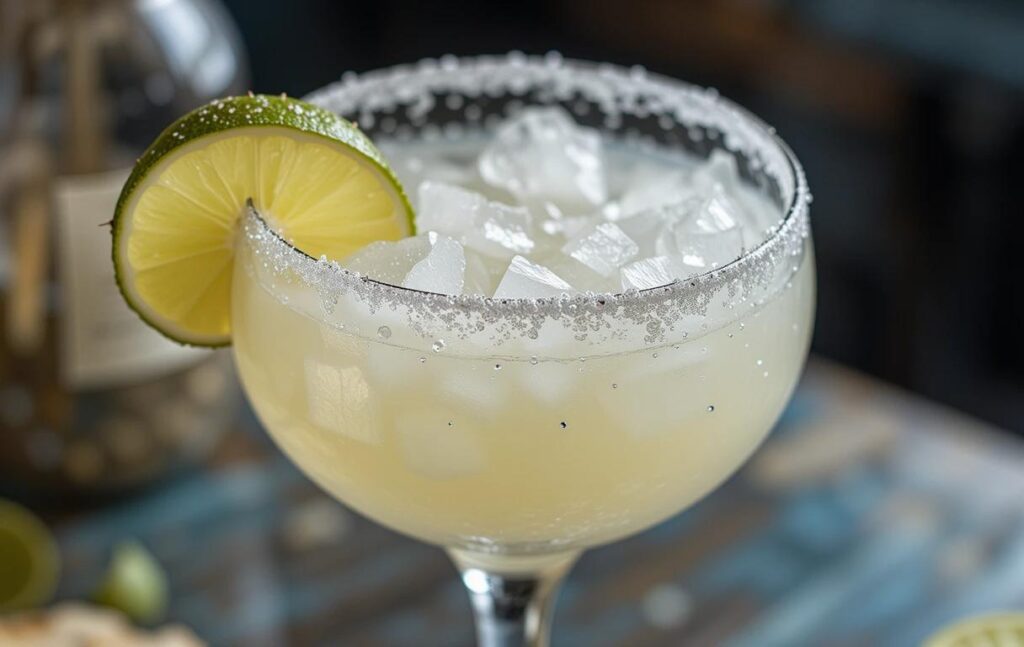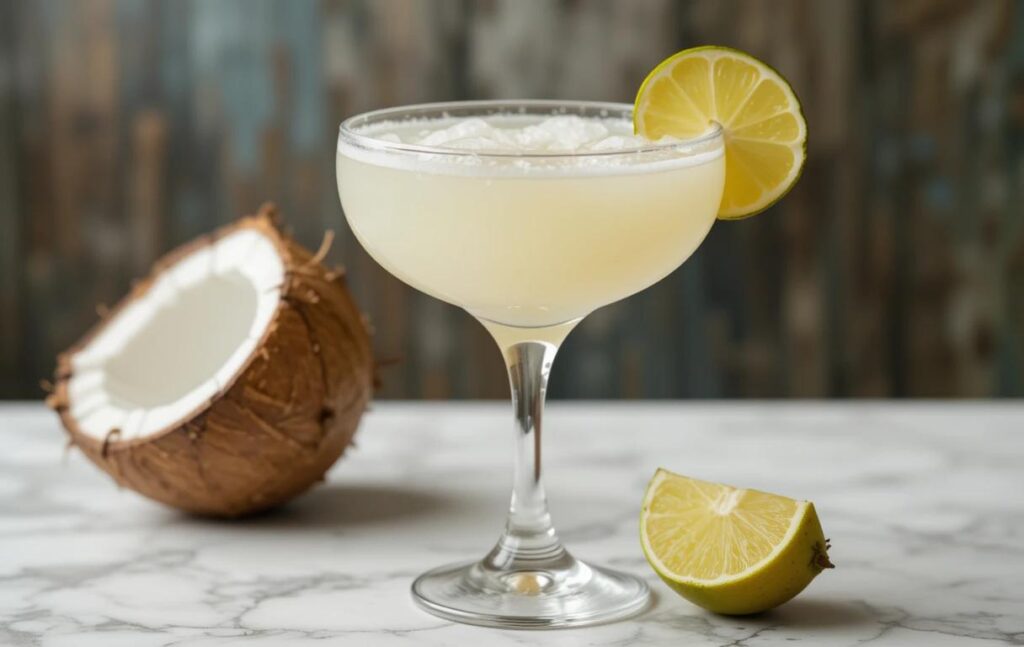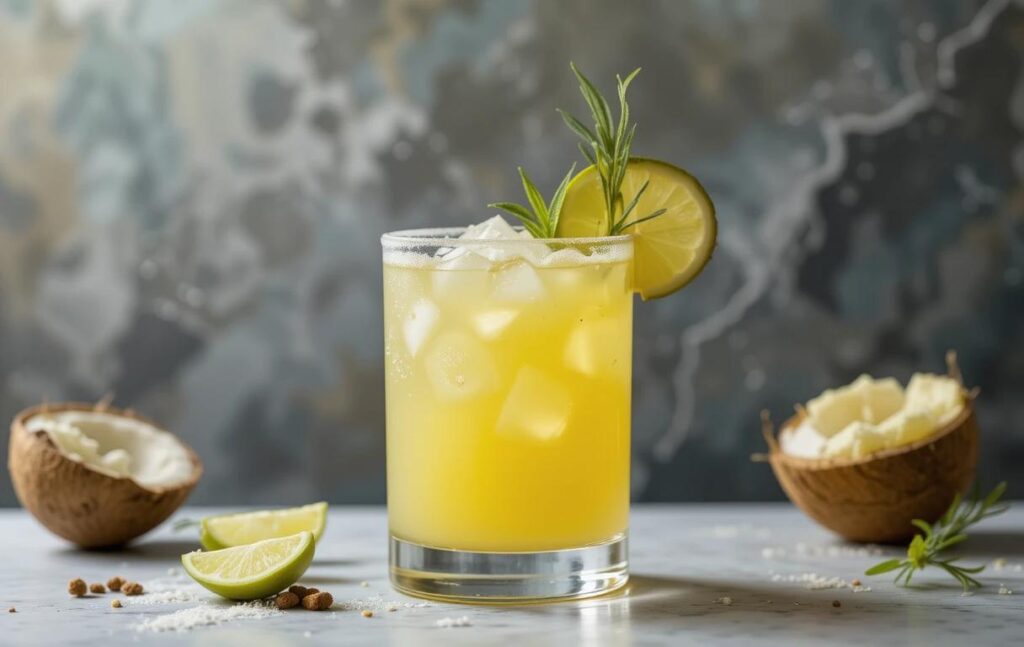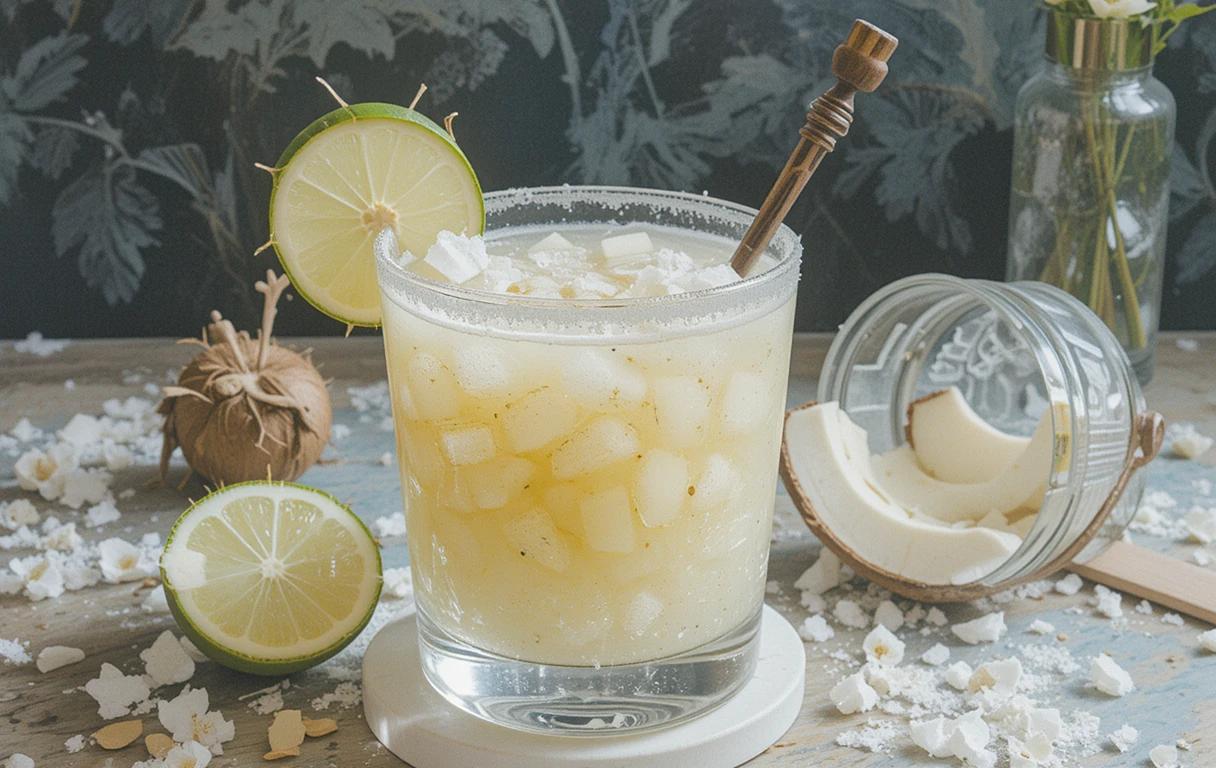Introduction to Coconut Margarita
The Coconut Margarita is a tropical twist on the classic margarita, blending the vibrant flavors of tequila and lime with the creamy, rich taste of coconut. This cocktail is a refreshing and indulgent drink perfect for summer parties, beach vacations, or anytime you want to bring a touch of the tropics into your glass.
Unlike traditional margaritas that rely on orange liqueurs like Triple Sec, the coconut margarita often incorporates coconut milk, coconut cream, or coconut-flavored spirits. This gives the cocktail a luscious texture and a slightly sweet, nutty profile. The base remains tequila, typically blanco or reposado, which pairs beautifully with the coconut’s creamy undertones.
To enhance the experience, coconut margaritas are often garnished with toasted coconut flakes, lime wedges, or a coconut-sugar rim, adding a delightful visual and textural element to the drink.
Whether you’re a cocktail enthusiast or new to mixing drinks, the coconut margarita offers an easy-to-make yet sophisticated choice. It’s a delicious blend of classic margarita sharpness and the smooth, exotic flavor of coconut—a sip of paradise in every glass.
History and Origins
The Origin of Margaritas
The margarita, one of the most iconic cocktails in the world, has a somewhat mysterious origin story, with several competing claims to its creation. The drink, which traditionally combines tequila, lime juice, and orange liqueur, first gained popularity in Mexico and the United States in the mid-20th century. Some popular theories about its origins include:
- Tijuana, Mexico (1930s): It is believed that the margarita may have evolved from a drink called the “Daisy,” which uses tequila instead of brandy. The Spanish word for daisy is “margarita,” lending weight to this theory.
- Acapulco, Mexico (1940s): Socialite Margarita Sames is said to have created the drink at her vacation home in Acapulco, blending tequila, lime, and Cointreau to impress her guests.
- Carlos “Danny” Herrera: Another story credits Carlos Herrera, a bartender in Baja California, with inventing the margarita in the late 1930s for a customer who was allergic to all alcohol except tequila.
Regardless of its exact origin, the margarita gained widespread recognition during the 1950s and 1960s and became synonymous with warm-weather escapism, often associated with beaches, celebrations, and relaxation.
How Coconut Became a Popular Twist
Coconut has long been a staple ingredient in tropical drinks, thanks to its creamy texture and sweet, nutty flavor. The addition of coconut to margaritas likely emerged from the growing popularity of tropical and tiki cocktails during the mid-20th century. These drinks, which often feature coconut, pineapple, and rum, became fashionable due to the rise of tiki culture in the United States after World War II.
As the margarita became a globally beloved cocktail, mixologists and home bartenders began experimenting with variations, incorporating regional flavors and ingredients. Coconut became a natural choice for a tropical spin, enhancing the drink’s creamy richness while complementing tequila’s bold character.
The Coconut Margarita owes its popularity to the modern craft cocktail movement, which celebrates creative reinterpretations of classic drinks. Today, this twist on the traditional margarita is enjoyed worldwide, beloved for its perfect balance of tangy citrus, robust tequila, and silky coconut—a refreshing indulgence that transports drinkers to paradise with every sip.
Key Ingredients

Traditional Margarita Components
The classic margarita is a simple yet perfectly balanced cocktail made with three main ingredients:
- Tequila: The backbone of any margarita, tequila is typically made from blue agave and provides a robust, earthy flavor. Blanco (silver) tequila is most commonly used for its clean, crisp taste, but reposado tequila, aged in oak barrels, adds depth and complexity.
- Lime Juice: Freshly squeezed lime juice is essential for the margarita’s signature tangy and zesty flavor. It balances the sweetness of the other ingredients and highlights the tequila’s bold notes.
- Orange Liqueur: Orange liqueurs like Cointreau, Triple Sec, or Grand Marnier are used to add a subtle sweetness and citrusy depth. They round out the flavors and enhance the drink’s complexity.
Optional additions like simple syrup or agave nectar can be included for extra sweetness, while the traditional salted rim adds a savory touch that complements the cocktail’s tart and sweet profile.
Importance of Coconut Cream and Other Variations
When creating a Coconut Margarita, the addition of coconut cream or other coconut-based ingredients transforms the drink into a creamy, tropical delight. Here’s how these components elevate the cocktail:
- Coconut Cream or Coconut Milk: The rich, silky texture of coconut cream (or the lighter alternative, coconut milk) brings a luxurious mouthfeel and a subtle, natural sweetness. It complements the acidity of the lime and balances the tequila’s intensity.
- Coconut-Flavored Spirits: Some recipes incorporate coconut-flavored liqueurs or infused tequilas for an extra punch of coconut flavor, deepening the tropical theme.
- Sweeteners: Variations may use agave syrup, honey, or simple syrup to amplify the sweetness and blend harmoniously with the coconut’s nuttiness.
- Additional Ingredients: Pineapple juice, mango puree, or other tropical fruit flavors are often added to expand on the coconut theme, creating exciting flavor combinations.
- Garnishes: Toasted coconut flakes, lime wedges, or a coconut-sugar rim enhance the presentation and add complementary flavors.
Coconut cream is the star ingredient in this variation, as it not only provides the distinct coconut taste but also gives the margarita a creamy consistency that makes it more indulgent. Together with the traditional margarita ingredients, coconut transforms the cocktail into a tropical escape—perfect for a change of pace from the original.

How to Make a Perfect Coconut Margarita
Step-by-Step Recipe
Ingredients:
- 2 oz (60 ml) tequila (preferably blanco or reposado)
- 1 oz (30 ml) coconut cream (e.g., Coco Lopez)
- 1 oz (30 ml) freshly squeezed lime juice
- 1 oz (30 ml) orange liqueur (e.g., Cointreau or Triple Sec)
- 0.5 oz (15 ml) simple syrup or agave nectar (optional, for added sweetness)
- Ice cubes
- Toasted coconut flakes (optional, for garnish)
- Lime wedge (for garnish and rimming the glass)
- Salt or coconut sugar (for rimming the glass)
Instructions:
- Prepare the Glass:
- Rub a lime wedge around the rim of a margarita or cocktail glass.
- Dip the rim into a plate of salt or coconut sugar to coat it. Set the glass aside.
- Combine the Ingredients:
- In a cocktail shaker, combine tequila, coconut cream, lime juice, orange liqueur, and simple syrup or agave nectar (if using).
- Add a handful of ice to the shaker.
- Shake:
- Secure the shaker lid and shake vigorously for about 15-20 seconds. This ensures the coconut cream is well-mixed and the drink is chilled.
- Strain and Serve:
- Fill the prepared glass with fresh ice.
- Strain the cocktail mixture into the glass.
- Garnish:
- Add a lime wedge to the rim of the glass.
- Sprinkle a few toasted coconut flakes on top for an extra tropical touch.
- Enjoy:
- Serve immediately and savor the creamy, tropical flavors.
Tips for Achieving the Best Flavor
- Use High-Quality Ingredients:
- Opt for 100% agave tequila and fresh lime juice for the best taste.
- Choose a rich and flavorful coconut cream, as it’s the centerpiece of the cocktail.
- Balance Sweetness:
- Adjust the sweetness to taste by adding simple syrup or agave nectar sparingly. Let the natural sweetness of the coconut shine through.
- Shake Well:
- Shaking vigorously ensures the coconut cream integrates fully with the other ingredients, creating a smooth and creamy texture.
- Chill Everything:
- Use chilled ingredients and fresh ice to keep the drink refreshingly cold.
- Customize Garnishes:
- Enhance the presentation with a coconut-sugar rim or a sprinkle of toasted coconut flakes. It adds texture and a delightful aroma.
- Experiment with Variations:
- Add a splash of pineapple juice or mango puree for a fruitier twist.
- For a frozen version, blend the ingredients with ice instead of shaking.
By following these steps and tips, you can craft a perfect coconut margarita that is creamy, tangy, and irresistibly tropical—a true sip of paradise!
Health Benefits of Coconut
Nutritional Benefits of Coconut
Coconut, in its various forms, offers several nutritional benefits that make it a valuable ingredient beyond its delightful flavor. Here are some key benefits:
- Rich in Healthy Fats:
- Coconut contains medium-chain triglycerides (MCTs), a type of fat that is more easily digested and quickly metabolized by the body for energy. These fats may support weight management and boost energy levels.
- Supports Heart Health:
- Coconut oil and coconut cream contain lauric acid, which may help increase good HDL cholesterol levels, contributing to improved heart health.
- Hydration:
- Coconut water, a natural electrolyte-rich liquid found in coconuts, can help with hydration and maintaining electrolyte balance.
- Boosts Immunity:
- The lauric acid in coconut has antimicrobial and antibacterial properties, which may support immune function.
- Rich in Nutrients:
- Coconut is a good source of essential nutrients like manganese, which supports bone health and metabolism, and copper, which aids in iron absorption and the production of red blood cells.
- Low Glycemic Index:
- Coconut products have a low glycemic index, meaning they don’t cause rapid spikes in blood sugar levels.
Low-Calorie Options for a Guilt-Free Drink
While coconut cream adds richness to a coconut margarita, it can also increase the calorie count. Here are some tips for creating a lighter, low-calorie version of the drink:
- Swap Coconut Cream for Coconut Milk:
- Use light coconut milk instead of coconut cream. It has fewer calories and a thinner consistency while still providing a hint of coconut flavor.
- Reduce Sweeteners:
- Skip the simple syrup or agave nectar if the drink is already sweet enough from the coconut and orange liqueur.
- Opt for Coconut Water:
- Replace coconut cream or milk with coconut water for a lighter, hydrating version. Coconut water adds a subtle coconut flavor without the creaminess or extra calories.
- Use Low-Calorie Tequila Alternatives:
- Some brands offer low-calorie or flavored tequilas, which can enhance the drink’s flavor without additional calories.
- Control Portion Size:
- Serve the drink in smaller glasses or adjust the recipe proportions to create a lower-calorie cocktail.
- Frozen Coconut Margarita:
- Blend the drink with ice for a frothy texture that feels indulgent without adding cream or milk.
- Garnish Smartly:
- Use lime wedges or a minimal sprinkle of toasted coconut flakes as garnish instead of a sugar or salt rim to keep the calorie count low.
By incorporating these options, you can enjoy a refreshing coconut margarita that’s both delicious and mindful of your health goals. Coconut’s natural benefits combined with these low-calorie strategies make it a drink you can savor without guilt.
Serving Coconut Margaritas for Occasions
Ideal Settings for Serving
Coconut Margaritas are versatile and perfect for a variety of settings, especially those that emphasize relaxation and celebration. Here are some ideal occasions:
- Summer Parties and Barbecues:
- The tropical flavors make Coconut Margaritas a hit at outdoor gatherings. Serve them alongside grilled dishes and fresh salads for a crowd-pleasing pairing.
- Beach or Poolside Gatherings:
- These cocktails are synonymous with the beachy vibe. Offer them to guests lounging by the pool or enjoying a coastal retreat.
- Tropical-Themed Events:
- A must-have for luaus or Caribbean-inspired parties, Coconut Margaritas add authenticity to the tropical theme.
- Weddings and Celebrations:
- Coconut Margaritas can serve as a signature cocktail at weddings, anniversaries, or engagement parties with a tropical or summery theme.
- Brunches and Casual Get-Togethers:
- Their light and creamy texture pairs well with a relaxed brunch setting. Serve them as a refreshing alternative to mimosas or sangria.
- Holiday Parties:
- Add a tropical twist to winter holidays with Coconut Margaritas. Garnish with a sprinkle of nutmeg or cinnamon for a festive touch.
Pairing with Food
Coconut Margaritas are flavorful yet balanced, making them excellent companions to a variety of dishes. Here are some pairing suggestions:
- Seafood:
- The cocktail’s tropical notes complement seafood dishes like grilled shrimp, fish tacos, ceviche, or coconut-crusted fish.
- Spicy Foods:
- Coconut Margaritas pair wonderfully with spicy cuisines, such as Mexican (enchiladas, spicy salsas) or Thai (green curry, spicy noodles). The coconut helps mellow the heat.
- Tropical-Inspired Appetizers:
- Serve alongside coconut shrimp, mango salsa with tortilla chips, or pineapple skewers for cohesive flavors.
- Grilled Dishes:
- The smoky char of grilled chicken, pork, or vegetables pairs beautifully with the creamy and tangy cocktail.
- Fruity Desserts:
- Enhance the tropical theme by pairing Coconut Margaritas with desserts like mango sorbet, coconut macaroons, or pineapple upside-down cake.
- Light Salads:
- Fresh, citrusy salads with greens, avocado, or tropical fruits balance the richness of the cocktail.
- Cheese and Charcuterie Boards:
- Include tropical accompaniments like dried mango, coconut chips, or creamy cheeses to align with the margarita’s flavors.
By tailoring the food and atmosphere to the tropical vibe of Coconut Margaritas, you can create a memorable and delicious experience for your guests, no matter the occasion!
FAQs

How to Store Leftover Coconut Margaritas?
If you have leftover coconut margaritas, here’s how to store them for later:
- Refrigeration:
- Pour the leftover drink into an airtight container or a glass bottle with a secure lid.
- Store in the refrigerator for up to 2 days. Shake well before serving, as the ingredients may separate.
- Freezing:
- For a longer shelf life, freeze the margaritas in a sealed container. When ready to serve, allow the mixture to thaw slightly and blend with ice for a frozen version.
- Avoid Adding Ice in Advance:
- If you plan to store leftovers, don’t include ice in the container, as it will dilute the drink over time. Instead, add fresh ice when serving again.
Can I Use Coconut Milk Instead of Coconut Cream?
Yes, you can use coconut milk as a substitute for coconut cream, but there are some differences to consider:
- Texture and Flavor:
- Coconut milk is lighter and less creamy than coconut cream, so the drink will have a thinner texture and a subtler coconut flavor.
- To mimic the creaminess, you can use full-fat coconut milk or add a small amount of sweetener like agave nectar.
- Low-Calorie Alternative:
- Coconut milk is a good option if you’re looking to reduce calories without compromising the coconut essence.
- Blending Tips:
- Shake or mix the coconut milk well before adding it to your cocktail to ensure a smooth consistency.
Conclusion
Why Coconut Margaritas Are Special
Coconut Margaritas elevate the classic margarita with a creamy, tropical twist that brings together the vibrant flavors of tequila, lime, and coconut. They are:
- Versatile: Perfect for a wide range of occasions, from casual gatherings to festive celebrations.
- Indulgent Yet Refreshing: Combining creamy richness with tangy citrus for a balanced and delightful experience.
- Customizable: Easy to adapt with low-calorie ingredients, fruity add-ons, or frozen variations to suit any preference.
Encouragement to Try and Share
Coconut Margaritas are more than just a drink—they’re an invitation to escape to paradise with every sip. Whether you’re hosting a party or enjoying a quiet evening, this cocktail is sure to impress. Try making your own Coconut Margarita today, and don’t forget to share the recipe and experience with friends and family for a truly tropical celebration! Cheers!
More Recipes
Related Recipes
- “Tuna Tomato Sauce Pasta Recipe“: A tomato-based recipe showcasing another way to use tomatoes.
- “Baked Chicken Fettuccine Alfredo with Broccoli“: Another comforting dish that can be complemented with tomato-based sauces.
Ingredient-Focused Content
- “Lions Mane Mushroom Recipe“: Suggest using a tomato gravy as a flavorful addition for plant-based dishes.
Cooking Techniques and Enhancements
- “Mango Habanero Salsa“: Explore complementary uses of sauces and gravies for flavor diversity.
Storage and Reuse Tips
- “Sous Vide Recipes“: Recommend tomato gravy as a sauce for sous vide-cooked meats or vegetables.
- “Ocean Spray Cranberry Sauce Recipe“: Guide readers on making and storing sauces, including tomato gravy.

